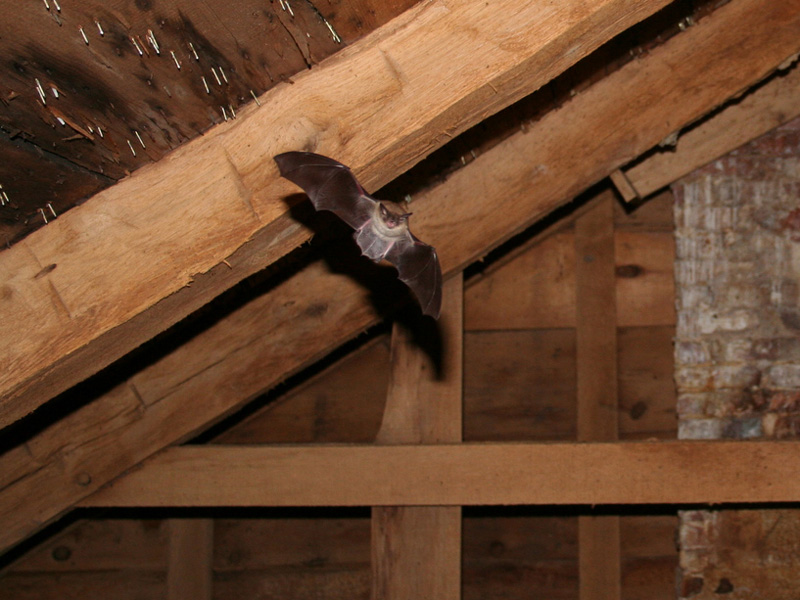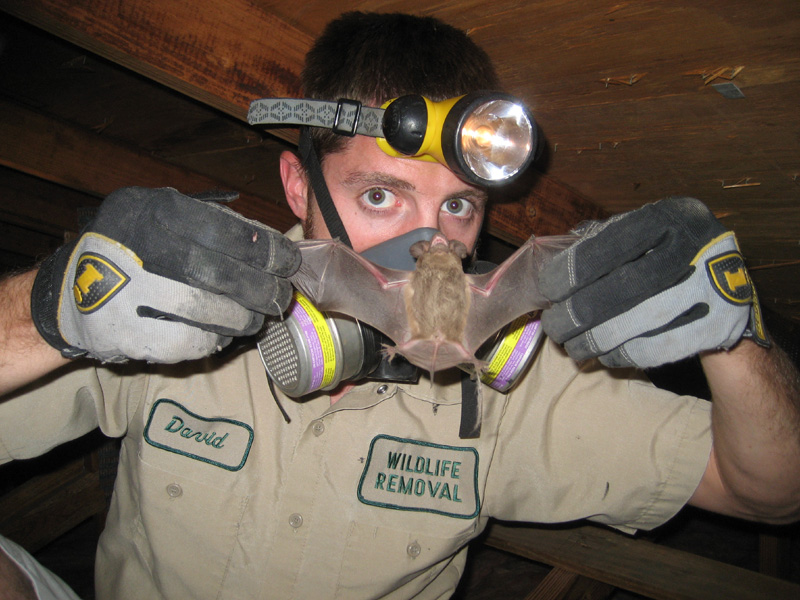- USA Wildlife Removal Education Guide and Resources
How to get bats out of the attic

- STEP 1 - Identify the species of bat. This is often determined by where in the country you live. Little Brown Myotis in the north, Brazilian Free-Tail bat in the south, etc. This info will let you know the materinty season, when you cannot do an exclusion.
- STEP 2 - Observe the house at dusk, and watch the bats fly out. This is crucial info to let you know where the bats are exiting, and how many (approximately) there are.
- STEP 3 - Enter the attic. You may or may not see the bats, depending on their roosting areas in the attic. They don't just hang from the ceiling. They usually jam themselves in tight piles down walls, eaves, etc. But you will likely see thousands of droppings.
- STEP 4 - Get on a ladder, and seal shut any and all possible entry holes and gaps. This work is actually easier at night with a headlamp, when vision is better. DO NOT SEAL SHUT THE PRIMARY EXIT HOLES.
- STEP 5 - Install the proper one-way exclusion devices on the exit holes. This might be screening, netting, funnels, etc depending on the type of architecture. The bats must be able to freely exit, but not re-enter. Not easy.

- STEP 6 - Observe at dusk, to make sure the bats can get out. If not IMMEDIATELY remove the exclusion devices and try again the next night.
- STEP 7 - Leave the exclusuion devices in place for at least three days, and monitor. You must watch at dawn to see how they react to the devices, and if they can get back in. Make sure, after three days, that no more bats are coming out. If they are, the exclusuion failed and you must start again.
- STEP 8 - Once you are sure all the bats are out, remove the exclusion doors and seal shut the last holes/gaps.
- STEP 9 - Clean and decontaminate the attic. This is a difficult and involved process.
Go back to the main Bat Removal page for more information about how to get bats out of the attic.

How many nights have you been lying in your bed, ready to doze off when all of a sudden, you hear this irritating thumping noise that just WILL NOT go away? If you experience this on a regular basis, there is a very good chance that you could be suffering from a bat infestation. Thankfully, this is fairly simple to fix when you have the know-how, without the help of expensive wildlife control options, (although they are highly advised to ensure the job will get done properly, and without hassle!) and we are going to tell you how!
Is it a bat? There is no point in effectively bat proofing your home unless you are one hundred percent sure that bats are actually the problem. There are a few ways that you can tell this:
- Are there entry points to the parts of the house that you think you can hear the bats?
- Around these entry points, are there patches of brown staining? This can be caused by the coloration of the bats fur as it flies in and out of the gap.
- Are there tiny droppings left behind that crumble easy in your hands, with bits of left over bugs in there? (We are not suggesting you actively go around fondling bat poop, but it does help to identify the creature – you should probably wear gloves!)
- You probably won’t actually see the bats themselves, aside from hot summer nights when they can be seen and occasionally heard leaving your home and flying around. Go up into the attic – if you can’t see them, you will see their droppings on the floor.
If you have holes in the framework of your home, they will get in. If your chimney has pulled from the main frame of your home slightly, they can get in there. Minor holes in roofs can become an entrance point, same with soffits and fascias – these will all need to be blocked up properly. One effective method is a “one-way” approach, where you seal all exits and entrances, bar one, and effectively cause them to leave and not get back in again.
If you are looking for a bat trapping method, you are going to be hard pressed to find one. The same can be said for repellants for these cute little creatures. Aside from patience and some clever thinking, there are very few ways for you to encourage the bats to leave the nest, so to speak, and if you want the job done properly and quickly, it is always best to call a qualified wildlife control company to get the job done.

